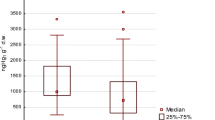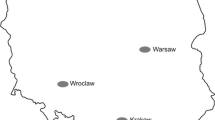Abstract
This study presents total mercury concentrations (HgT) in selected tissues and organs (blood, muscles, liver, kidneys, feathers and claws) of the herring gull (Larus argentatus) in order to assess the environmental pollution in the coastal zone of the southern Baltic. Dead, frozen birds were collected in the vicinity of Wladysławowo between December 2009 and March 2010, an exceptionally severe winter — a total of 13 specimens; 6 adults (>4 years old) and 7 immature birds (≤4 years old). Mercury concentrations in all analyzed samples exceeded the detection limit. The lowest average concentration, at a level of 0.4 μg Hg g−1 (d.w.) was observed in the muscles of adult and immature gulls while the highest, at a level of 3.3 μg Hg g−1 (d.w), was determined in the contour of immature gulls. A significant linear correlation was found between mercury concentration in the blood and the concentration in the kidneys and liver, with the coefficients of determination at R2 = 0.87 and 0.86, respectively. This indicates that blood of birds, as a mercury carrier, may reflects the concentration of mercury in tissues and internal organs of birds and, in the case of kidneys and liver, may express long-term exposure to mercury in nourishment.
Similar content being viewed by others
References
Arrhenius, F. & Hansson S. (1992). Food consumption of herring and sprat in the Baltic Sea. ICES, Baltic Fish Committee J, 7, 1–10.
Bartel, R. (2001). Return of salmon back to Polish waters. Ecology & Hydrobiology 1,3; 377–392.
Bignert, A., Litzén K., Odsjö T., Olsson M., Persson W. & Reutergårdh L. (1995). Time related factors influence the concentrations of sDDT, PCBs and shell parameters in eggs of Baltic Guillemot (Uria aalge), 1861–1989. Environmental Pollution, 89:27–36.
Bignert, A., Danielsson S., Nyberg E., Asplund L., Eriksson U., Berger U. & Haglund P. (2010). Comments Concerning the National Swedish Contaminant Monitoring Programme in Marine Biota, 2010. Report to the Swedish Environmental Protection Agency. Report nr 1:2010, — 154.
Brylińska, (2001). Ryby słodkowodne Polski. PWN Warszawa, 141–145.
Buszewski, B., Buszewska T., Chmarzyński A., Kowalkowski T., Kowalska J., Kosbucki P., Zbytniewski R., Namieśnik J., Kot-Wasik A., Pacyna J. & Panasiuk D. (2005). The present condition of the Vistula river catchment area and its impact on the Baltic Sea coastal zone. Reg Environ change. 5, 97–110.
Casini, M., Cardinale M. & Arrhenius F. (2004). Feeding preferences of herring (Clupea harengus) and sprat (Sprattus sprattus) in the southern Baltic Sea, ICES, J. Mar. Sci. 61, 1267–1277.
El-Mekkawi, H., Diab M., Zaki M. & Hassan A. (2009). Determination of chlorinated organic pesticide residues in water, sediments and fish farms at Abbassa and Shal Al-Husainia, Shakia governorate. Australian J. Bass. Appl. Sci. 3(4), 4376–4383
Evans, D.W., Dodo D.K. & Hanson P.J. (1993). Trace-element concentrations in fish livers: implications of variations with fish size in pollution monitoring. Mar. Pollut. Bull. 26, 329–334.
Falandysz, J., Brudnowska B., Iwata H. & Tanabe S. (1999a). Organochlorine pesticides and polichronated biphynls in the ambient air in city of Gdansk. Roczniki PZH. 50(1), 39–48.
Falandysz, J., Strandberg B., Strandberg L., Bergqvist P. A. & Rappe Ch. (1999b). Dieldrin, aldrin, endrin, isodrin, endosulphan 1 and 2 on fish in the Gulf of Gdansk, Roczniki PZH. 50(2), 131–138.
Falandysz, J. & Strandberg B. (2004). Persistent organochlorine compounds in sludge and sediments from tha Gdansk region, Baltic Sea. Pol. J. Env. Stud. 13(2), 133–138
Falkowska L., Reindl A.R., Szumiło E., Kwaśniak J., Staniszewska M., Bełdowska M., Lewandowska A. & Krause I. (2013). Mercury and chlorinated pesticides on the highest level of the food web as exemplified by herring from the Southern Baltic and African penguins from the zoo. Water Air and Soil Pollution 224:1549. DOI: 10.1007/s11270-013-1549-6
Gąsowska, M. (1962). Klucze do oznaczania kręgowców Polski. Cz. I, Kręgłouste-Cyclostomi, Ryby-Pisces. Opracowanie zbiorowe, PWN, Warszawa, Kraków. 240.
Grynkiewicz, M., Polkowska Ż., Górecki T. & Namieśnik J. (2001). Pesticides in precipitation in the Gdańsk region (Poland). Chemosphere. 43, 303–312
HELCOM, (2010). Hazardous substances in the Baltic Sea — An integrated thematic assessment of hazardous substances in the Baltic Sea. Balt. Sea Environ. Proc. No. 120B.
Jackowski, E. (2002). Ryby Zatoki Puckiej. Monografia rybacka, Wydaw. Mor. Inst. Ryb., Gdynia. 108.
Koistinen, J. Kiviranta H, Ruokojärvi P, Parmanne R, Verta M, Hallikainen A & Vartiainen T. (2008). Organohalogen pollutants in herring from the northern Baltic Sea: concentrations, congener profiles and explanatory factors. Environ Pollut. 154(2), 172–183.
Kosikowska M., Szymańska M. & Biziuk M. (2011). Determination of pesticides residues in ambient air in tri-city. [in:] JakośĆ Powietrza a jakośĆ życia. W. Wardencji (ed.), 63–69.
Kosior, M., Trella K.K. & Jaworski A., (2001). Fecundity of cod (Gadus morhua callarias L.) in the southern Baltic in the late 1990s. Acta Ichthyol. Piscat. 31(2), 55–75.
Kot-Wasik, A., Dębska J. & Namieśnik J. (2004). Monitoring of organic pollutants in coastal waters of the Gulf of Gdansk, Southern Baltic. Mar. Poll. Bull. 49, 264–276.
Kwaśniak J. & Falkowska L. (2012). Mercury distribution in muscles and internal organs of the juvenile and adult Baltic cod (Gadus morrhua callarias Linnaeus, 1758). Oceanol. Hydrobiol. Stud. 41(2), 65–71. DOI: 10.2478/s13545-012-0018-y
Moilanen, R., Pyysalo H., Wickströmm K. & Linko R. (1982). Time trend of chlordane, DDT and PCB concentration in Pike (Esox Lucius) and Baltic Herring (Clupea harengus) in the Turku Archipelago, Northern Baltic Sea for the period 1971–1982. Bull. Environm. Contam. Toxicol. 29, 334–340.
Nfon, E, Cousins I.T. & Broman D. (2008). Biomagnification of organic pollutants in benthic and pelagic marine food chains from the Baltic Sea. Sci Total Environ. 397(1–3), 190–204.
Olsson, M., Bignert, A., Aune, M., Haarich, M., Harms, U., Korhonen, M., Poutanen, E., Roots, O. & Sapota, G. (2003). Organic contaminants. Chapter in Forth Periodic Assessment of the State of the Marine Environment of the Baltic Sea Area, 1994–1998. Baltic Marine Environment Protection Commission 2002. pp 133–140.
Reindl, A.R., Bolałek J. & Falkowska L. (2013). Persistent organic pollutants (POPs) in the marine food web: herrings from the southern Baltic Sea (Clupea harengus) — penguins from the zoo (Spheniscus demersus). Oceanol. Hydrobiol. Stud. 42(1). DOI: 10.2478/s13545-000-0000-0
Roots, O. & Talvari A. (1997). Bioaccumulation of the toxic chlororganic compounds and their isomers into the organism of Baltic grey seals. Chemosphere. 35(5), 979–985.
Sapota, G. (1997). Chlorinated hydrocarbons in sediments from the Vistula Lagoon. Oceanol. Hydrobiol. Stud. 26(2–3), 61–69.
Sapota, G. (2006). Decreasing trend of persistent organic pollutants (POPs) in herring from the southern Baltic Sea. Oceanol. Hydrobiol. Stud. 35(1), 15–21.
Strandberg, B., Strandberg L., van Bavel B., Bergqvist P.A., Broman D., Falandysz J., Näf C., Papakosta O., Rolff C. & Rappe C. (1998a). Concentrations and spatial variations of cyclodienes and other organochlorines in herring and perch from the Baltic Sea. Sci Total Environ. 215(1–2), 69–83.
Strandberg, B., Bandh C., Van Bavel B., Bergqvist P. A., Broman D., Näf C., Pettersen H. & Rappe C. (1998b). Concentrations, biomagnification and spatial variation of organochlorine compounds in a pelagic food web in the northern part of the Baltic Sea, Sci. Tot. Environ. 217, 143–154.
Szlinder-Richert, J., Barska I., Mazerski J. & Usydus Z. (2008). Organochlorine pesticidies in fish from the southern Baltic Sea — levels, bioaccumulation features and temporal trends during the period from 1997 to 2006. Mar. Poll. Bull. 56(5), 927–940.
Terlecki, J. (2000). Ciosa, Pelecus cultratus (Linnaeus, 1758). In: Ryby słodkowodne Polski. M. Brylińska (ed.). Warszawa, PWN. 322–328.
Wiener, J. G., Krabbenhoft D. P., Heinz G. H. & Scheuhammer A. M. (2003). Ecotoxicology of mercury. In: Hoffman, DJ, Rattner BA, Burton GA, Cairns J, editors. Handbook of ecotoxicology. Boca Raton7 Lewis Publ. 409–463.
Wiśniewolski, W., Augustyn L., Bartel R., Depowski R., Dębowski P., Klich M., Kolman R. & Witkowski A. (2004). Możliwości odtworzenia populacji ryb wędrownych (jesiotra — Acipenser sturio/A. oxyrhynchus, łososia — Salmo salar, troci — Salmo trutta trutta i certy — Vimba vimba) w polskich rzekach. WWF Polska, Warszawa. 42.
Vorkamp, K., Christensen J. H., Glasius M. & Riget F. F. (2004). Persistent chalogenated compounds in black guillemots (Cepphus grylle) from Greenland — levels, compound patterns and spatial trends. Mar. Poll. Bull. 48, 111–121.
Zitko, V. (2003). Chlorinated pesticides: Aldrin, DDT, endrin, dieldrin, mirex. Pages 47–90 in The Handbook of Environmental Chemistry (H. Fiedler, ed), vol. 3, Part O, Persistent Organic Pollutants. Springer Verlag Berlin, Heidelberg.
Author information
Authors and Affiliations
Corresponding author
About this article
Cite this article
Szumiło, E., Szubska, M., Meissner, W. et al. Mercury in immature and adults Herring Gulls (Larus argentatus) wintering on the Gulf of Gdańsk area. Ocean and Hydro 42, 260–267 (2013). https://doi.org/10.2478/s13545-013-0082-y
Received:
Accepted:
Published:
Issue Date:
DOI: https://doi.org/10.2478/s13545-013-0082-y




